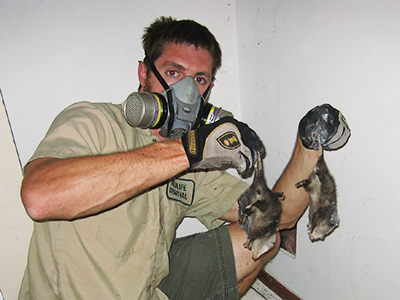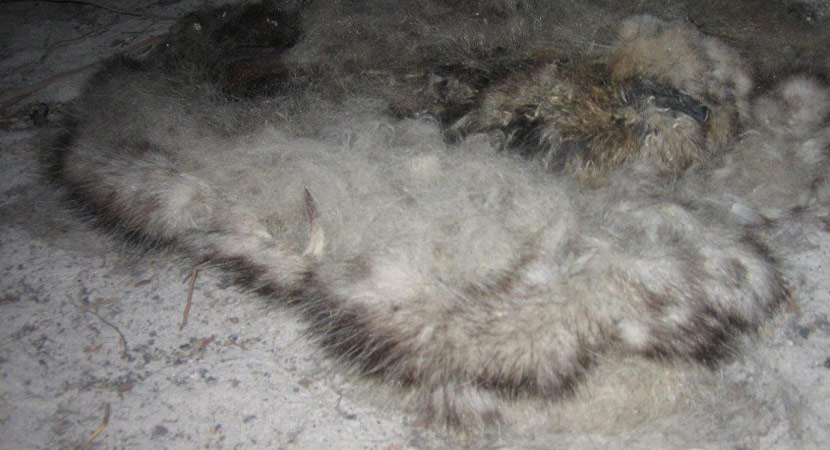Call me: 502-805-6786
Welcome to Louisville Dead Animal Removal! Got a terrible smell in your house, or do you see a dead critter on your property? We are an animal control company specializing in the removal of dead animals from your home, attic, basement, walls, yard, or any part of your property. You clearly don't want a dead animal in your house. Carcasses attract flies and give off terrible smells, not to mention the potential diseases rotting flesh can cause. Whenever we remove dead animals, we use 100% safe methods and make sure to disinfect your home and get rid of all traces of odor. Click here for Free Roadkill Removal and click here for Dead Pet Body Removal. For deceased wild animals in your home or property, call us anytime at 502-805-6786 to schedule an appointment for today! We come out fast! Some of the services we offer include:
- Dead Animal Removal
- Foul Odor Diagnosis
- Full Property Inspections
- House Damage Repairs
- Dead Body Location Services
- Proper Carcass Disposal
- Cleanup & Decontamination Services
- Deodorization Services
CALL US ANYTIME AT 502-805-6786

Some wild animals, especially infants, can be trapped in the inaccessible part of our house. They will eventually die from dehydration and starvation. Other companies will just mask the scent and cross their fingers that it will solve the case. However, that won't be enough. Dead animals can invite insects such as beetles and flies; it can also draw the attention of scavengers. Additionally, merely concealing the scent will not eliminate the health risks associated with them. Our company has more than ten years of experience in delivering dead animal removal service. We know the demands and the needs of the customers and understand their concerns. We will work hard to ensure that your property will be a safe and comfortable place for the whole family. We have the right tools and safety gear to help us extract the animals in the narrow spaces of your house. Our people will wear hazmat suits, protective gloves, and organic vapor cartridge respirator to keep them safe from the threat of zoonotic diseases. After removing the dead body, we will place it in a secured container and prepare it for incineration in our facility. We will then decontaminate the property to eliminate the threats that are invisible to the naked eye. We will then use deodorizers such as antibacterial sprays and ozone air cleaners to neutralize the scent completely.
What Prices Do We Charge?
Learn about dead animal removal costs - each situation is different!
What if you found roadkill or a dead animal such as a deer in a public place, and you want the city or Jefferson County services to remove it for free? Click here for Free Jefferson County Dead Animal Removal services. What if a farm animal like a horse, or your beloved pet dog or pet cat has died and you need the body taken away? Click here for Dead Pet Body Removal.
We are experts in dead animal removal, and take our job seriously. When removing dead animals, we do a COMPLETE job — not only do we remove the dead animal from your home or yard, we also decontaminate the area, deodorize it, and dispose of the animal or cremate it. If you aren't sure whether the stench in your house is due to a rotting carcass or another reason, we can sniff it out with our noses from our years of experience. We remove dead raccoons, dead opossums, dead skunks, dead squirrels, dead birds, even dead dogs and cats. We frequently remove dead rodents from inside walls, because poison kills rats and mice, who die in your house. We completely solve your dead animal problem by taking these steps:
- Sniff out the dead animal if it is somewhere in your home
- When necessary, for example if the animal is in a wall or under your house, cut a hole to remove the animal
- Remove the dead animal, safely and completely (and seal the hole if needed)
- Finish the job by decontaminating and deodorizing your home
- Properly dispose of the dead animal through incineration or other means
- Prevent it from happening again by finding out how they got in your house
Dead animal carcass removal is specialty work. Sometimes the job is simple, such as a dead opossum in the yard, in which case we can simply wear our gloves and respirator mask, bag the carcass, and take it away for incineration. Sometimes this is more complex, such as when the dead animal is under a home crawlspace, under a porch or deck or shed. Or if the animal is larger, such as a dog or a deer. The most complex cases are dead animals inside the house. The animal may have died inside the attic, or down in the walls, or the duct work, or any other part of the architecture. You may have a bad smell in your home, and you're not even sure what's causing it. We've removed not just dead animals, but rotting food, bad mold, etc. We specialize in locating the source of the smell, and we very commonly cut a hole in the ceiling or wall to remove the animal. We remove every bit of the carcass, mop up the juices, vacuum the maggots, spray it and wipe it down with disinfectant, cleaner, and we repair the hole we cut. In some cases we use ozone machines to neutralize odor.
Louisville Dead Animal Tip: How to Cut Out a Dead Animal from Inside a Wall

Several animal species have learned to depend on humans for shelter. Little wonder they’ve turned houses into their jungle homes. That’s why you’ll see raccoons in chimneys, squirrels in attics, or opossums under crawl spaces. Not only do these creatures reside in strange places, but they also die in strange places - for instance, in walls. But why would an animal die inside a wall? There are several possibilities, and some include:
Being Stuck
Animals sometimes get into some places, and they get stuck. For instance, a raccoon might fall within your walls and find it difficult to escape. When that happens, it slowly dies of hunger, thirst, and exhaustion.
Health Reasons
When an animal has failing health, either due to injury, sickness, or even old age, it retreats to a secluded place. Inside a wall is an ideal position for a dying animal to rest. It then gradually loses its life.
What matters more than why an animal dies inside a wall is how to get rid of it so you can eliminate the foul smell and nuisance pests the carcass has attracted. In this article, we work you through the steps of cutting out a dead animal from inside a wall.
Steps to Cut Out a Dead Animal from Inside a Wall
Step 1: Pinpoint the room where the dead animal is.
When an animal dies, decomposition starts. During decomposition, the carcass releases bodily fluids and gases with a foul smell. Air currents carry the foul odor to saturate your entire house. Searching the entire house is too much work. That’s why you need to pinpoint the room the animal is located in. Follow the smell to the room where the odor is most concentrated - that’s where the carcass is.
Step 2: Sniff on the wall with your nose.
Now, you know the room where the carcass is but it could be anywhere inside the wall. That’s why you need to sniff on the wall with your nose. You might be wondering if it’s possible to smell through a wall. Well, when you have a dead animal, the putrid smell will permeate through the wall. As you move your nose across the wall, you’ll notice a changing concentration of the foul smell. The spot where the odor is most concentrated is where the carcass is located.
Step 3: Use a drywall saw to cut a hole in the wall.
Once you find the spot, use a pencil to draw a square (or four-cornered box) around the spot on the wall. Thereafter, carefully use the saw to cut across the outlines you’ve drawn. Cutting a square hole is the best approach because it makes it very easy to fix the detached piece once you’ve removed the carcass.
Step 4: Remove the dead animal with rubber gloves.
Once you’ve made an opening, you should see the carcass. Avoid direct contact with the dead body because of the health risks it might pose. That’s why you must wear hand gloves before you pick up the carcass. After removing the carcass, place it in a plastic bag. Pick up other decaying matter and maggots and place them in the bag also.
Step 5: Dispose of the bag.
Depending on your district, the waste collection service might be able to pick up the carcass. You might also burn or bury the carcass. Make sure you check with your local wildlife authority to know the right way to dispose of a dead animal.
Step 6: Decontaminate your wall.
The next step is to clean up your wall. Mop up any bodily fluids and maggots. Then spray down the area with a special enzyme-based cleaner to destroy biohazard waste.
Step 7: Patch up the hole.
Remember the square drywall you removed from the wall? It’s now time to fix it back and glue it in place. But if that piece of drywall has been soiled or stained by the carcass, then you need to replace it with a new one. Cut up new drywall that’s the same size as the hole and use it to patch it up.
We service nearby towns such as Louisville, Jeffersontown, Saint Matthews, Shively, Middletown, Hurstbourne, Anchorage, Indian Hills, Lyndon, Audubon Park, Glenview, Douglass Hills, Fincastle, West Buechel, Graymoor-Devondale, Watterson Park, Heritage Creek, Barbourmeade, Windy Hills, Brownsboro Farm, Blue Ridge Manor, Strathmoor Village, Rolling Hills, Meadow Vale, Riverwood, Mockingbird Valley, Saint Regis Park, Bellewood, Hurstbourne Acres, Beechwood Village, Broeck Pointe, Houston Acres, Forest Hills, Hollow Creek, Brownsboro Village, Coldstream.